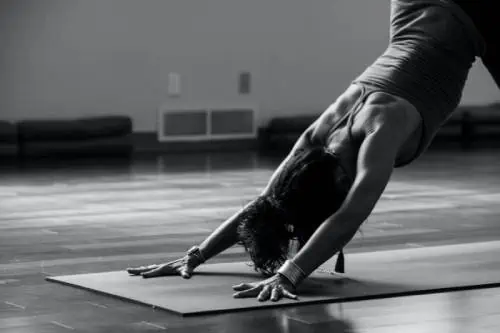Listen to this article:
Key Takeaway
Discover the rejuvenating power of the five Tibetan rites, a series of exercises that promise increased vitality and a youthful essence, akin to yoga but with an ancient twist for age-defying benefits.
Looking for a free anti-aging technique or an easy way to keep your body healthy and youthful? If so, check out the five Tibetan rites. These five exercises are similar to yoga poses and boast many of the same benefits, with the added elixir of eternal youth!
Are you wondering what this mystical practice is all about? Read on to discover the five Tibetan rites and how to do them.
Contents
What Are the Five Tibetan Rites?
The five Tibetan rites are a sequence of dynamic exercises historically practiced by Tibetan monks for health and vitality. The five movements are comparable with the postures practiced in yoga, including some of the most popular yoga poses.
What’s more, like yoga, it is said that practicing Tibetan rites activates the chakra system (energy centers). Each chakra is associated with a particular bodily system or set of organs. Therefore, practicing the 5 Tibetan rites is believed to enhance their functioning and keep them free from the adverse effects of aging.
History Of The Tibetan Rites
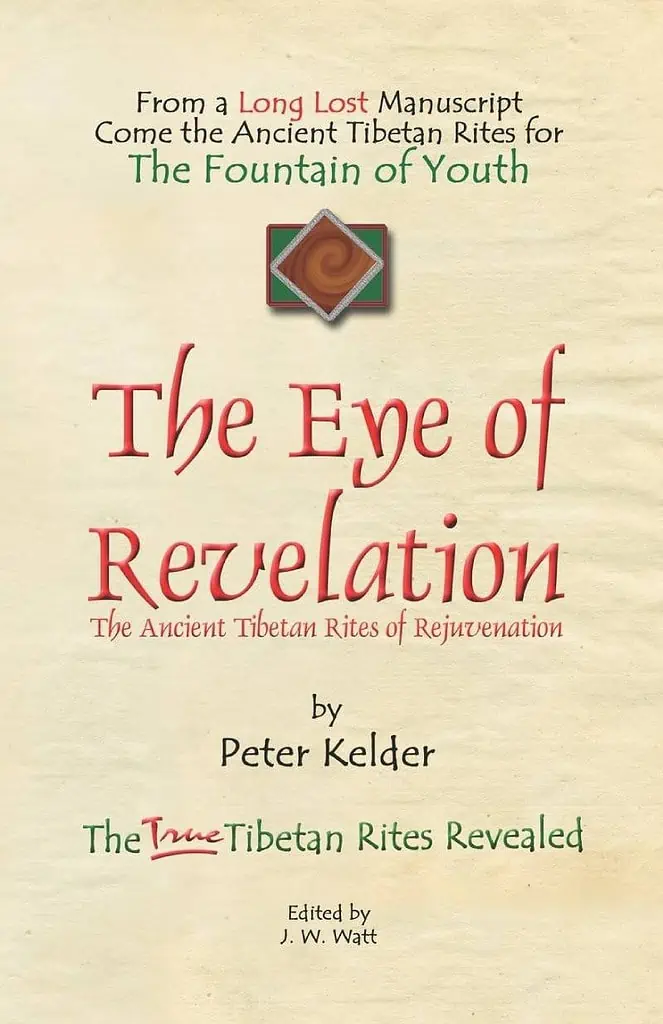
The true origin of the five Tibetan rites is unclear and often disputed. Still, the common belief is that they originated in India over 2500 years ago.
The Tibetan rites method was first publicized in 1939 in the book “The Eye of Revelation” by Peter Kelder. Kelder’s story is that a British army officer named Colonel Bradford came across the five rites while stationed in India.
Colonel Bradford hears about a group of lamas who claim to have found the “fountain of youth” at a particular lamasery. Bradford then went to the lamasery, where he lived with the lamas and learned from them the five rites.
The story also mentions seven spinning vortexes within the body, which are believed to refer to the yogic energy system known as the chakras. The lamas thought that the spin rate of the “vortexes” slows as we get older, which is the cause of age-related ill-health. However, practicing the five Tibetan rites is said to keep the energy centers spinning at an optimum rate and, thus, maintain good health.
In 1998, Kelder released a second book on the subject, “Ancient Secret of the Fountain of Youth,” where he gave more practical information on practicing the 5 Tibetan rites. Moreover, in 1994, researcher Chris Kilham wrote the book The Five Tibetans, telling the same story of the practices’ origin. Both authors emphasize the importance of practicing all five poses every day.
Benefits Of Practicing The Five Tibetan Rites
Unlike yoga, there is limited scientific research on Tibetan rites, so it is important to note that the benefits they claim to have are not proven. However, in “The Eye of Revelation” and “Ancient Secret of the Fountain of Youth,” Peter Kelder claims that the Tibetan Rites are a method of increasing longevity and maintaining youth.
Kelder reports that the ancient Tibetan monks experienced the following benefits:
- Reversal of the aging process
- A more youthful appearance
- Improved overall health and well-being
- Increased romantic energy
- Hair regrowth
- Weight loss
- Improved memory
In addition, as the exercises are similar to (or the same as) yoga postures, medical professionals believe practicing this system can provide some of the many benefits of yoga. These include:
- Increased energy
- Improved strength and flexibility
- Stress reduction
- Better sleep
- Relief from joint pain and muscular tension
- Improved digestion
How To Do The 5 Tibetan Yoga Poses
Traditionally, you are meant to repeat each exercise 21 times. However, as you can imagine, this can be exhausting and time-consuming, so it is not always realistic. What’s more, if you’re not a current yoga practitioner, you won’t be familiar with these dynamic movements, so you may find them difficult initially.
Therefore, starting with one to three rounds of each exercise is best; you can increase the repetitions as you progress. However, it is more important to focus on cultivating a regular practice than on how many repetitions you can do.
If you’ve been to yoga classes before, you’ve most likely heard yoga teachers tell you to listen to your body and only do as much as you can. You should follow that principle when practicing the five Tibetan rites and remember to maintain a connection to your breath at all times.
So, let’s break down each of the five Tibetans.
First Rite – Twirling
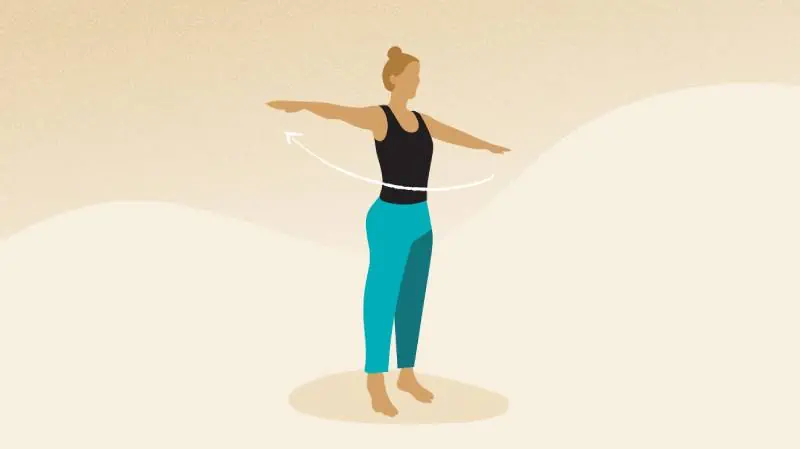
The first rite is known as twirling and is performed in a standing position.
- Stand with your feet shoulder-width apart. Have your arms outstretched and in line with your shoulders, palms facing down.
- Slowly start to spin in a clockwise direction, keeping your arms up and your breath steady. Keep your eyes open with your gaze towards the ground, and avoid tilting your head forward.
- Spin as many times as you want, up to 21 times. There is no need to go fast; just choose a speed that feels comfortable and does not compromise your balance. If you start to feel dizzy, stop immediately.
Second Rite – Leg Raises
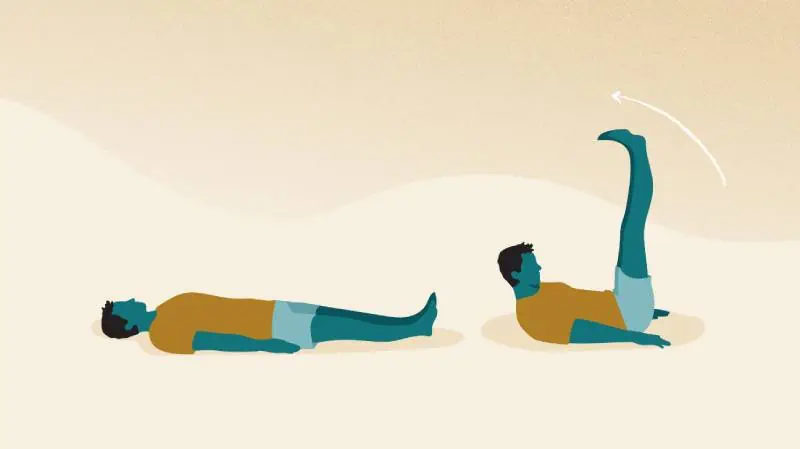
The second rite is performed in a reclined position.
- Have your legs stretched out (feet together) and arms by your sides.
- Engage your core and slowly raise both legs together as you inhale. As you do this, lift your head and gaze at your thighs, bringing your chin to your chest. Keep your palms facing down, touching the ground.
- Exhale to lower your head and legs, keeping the legs straight and returning to the original position.
- Repeat for 1 to 21 times, linking each movement to each breath.
Note that this exercise strongly engages your core and should be avoided if you are pregnant, had recent abdominal surgery, or have a spinal injury. If it is too difficult, modify the posture by placing your hands under your buttocks or bending your knees as you lift and lower the legs.
Third Rite – Dynamic Camel
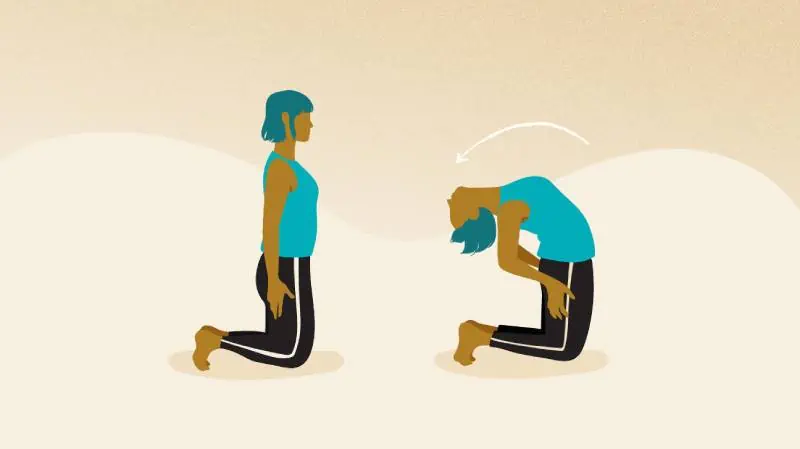
The third rite is a dynamic version of the yoga posture known as the camel pose.
- Come to a kneeling position with your hips stacked over your knees. If you have any knee pain, place a folded blanket under your knees.
- Place your hands flat on the back of your thighs. As you inhale, start to lean back, arching the spine as you slide your hands down your thighs. Press your chest forward and if it feels ok in your neck, tilt your head back. Be mindful of how it feels in your spine and don’t lean too far back the first time.
- As you exhale, come back up, straightening the spine and bringing the head forward.
- Repeat 1 to 21 times. If you are doing this one a few times, you have no back problems, and it feels fine, you can try to come a little bit further each time, strengthening the back muscles.
Like with all backbends, it’s essential to keep the core engaged by pulling the belly button inwards as you lean back. This will protect the lower back and prevent injury.
Fourth Rite – Moving Tabletop
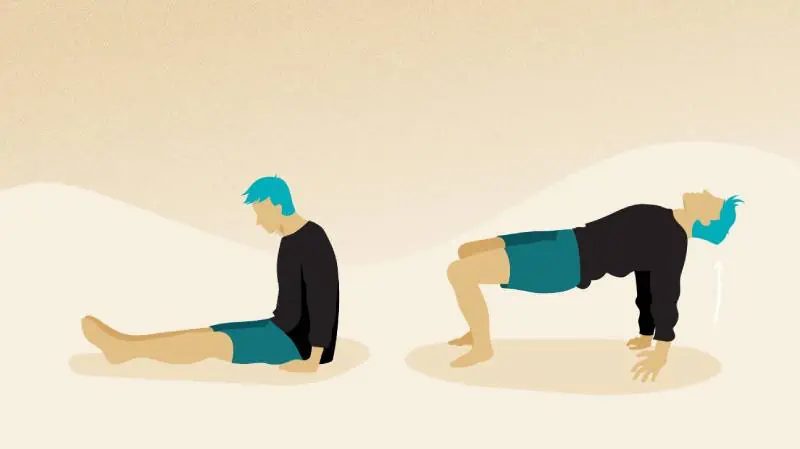
The fourth rite also requires core engagement and strengthens the abdominals, upper body, and upper legs.
- Start in a seated position with the legs straight and feet together. Place your hands by your sides with your palms flat on the floor. Ensure your spine is straight by focusing on drawing the tailbone down and the crown of the head up.
- Inhale to press your hands into the floor as you lift your hips and swing them forward while bending your knees. Your hips should come in line with your body, knees should be stacked over the ankles, and shoulders over the wrists in an upward tabletop position. If it feels ok, drop your head back.
- Exhale to slowly lower the hips by swinging them back and relax completely.
- Repeat up to 21 times.
As this exercise requires arm strength, you can modify it by starting with bent knees until you build up the power in your upper body.
Fifth Rite – Downward Dog To Upward Dog (two dogs)
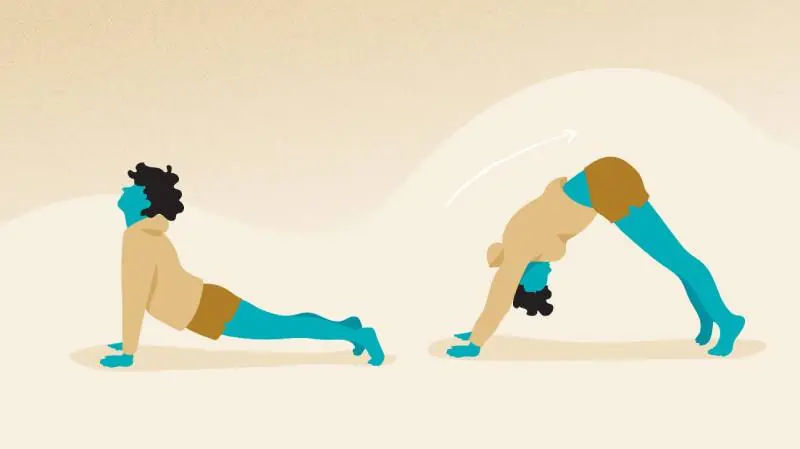
The last rite is called the two dogs. It features two common poses you have most likely heard your yoga instructor cue before – downward-facing dog and upward-facing dog.
- You can start in either pose, but most people find it easier to begin in a downward-facing dog. Start in a tabletop position, tuck your toes under, and lift your hips up and back while straightening your legs. Extend your arms and press your chest to your thighs, creating the shape of an upside-down V.
- Engage your core and bring your weight forward on an inhale into an upward-facing dog. Hips should be sinking, shoulders stacked over the wrists, and legs off the floor. Gaze up as you press your chest forward and tilt your head slightly back.
- As you exhale, return to the downward dog by lifting the hips up and back and repeat these two movements up to 21 times.
I recommend this YouTube video for a clear, follow-along visual demonstration of the 5 Tibetan rites.
Incorporating Tibetan Rites Into Your Yoga Practice
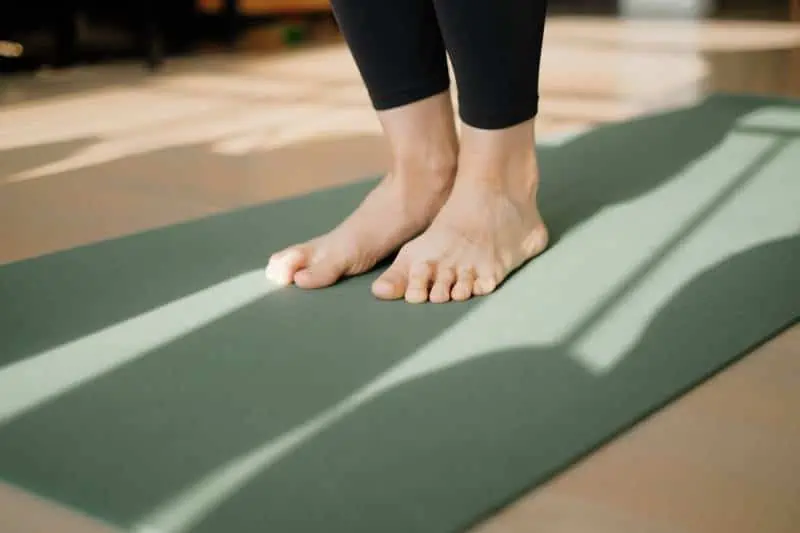
It is believed that traditionally the 5 Tibetan rites were practiced daily as a standalone practice. Thus, you can practice these exercises on your own as a short or long ritual, depending on how many rounds you do.
They can also be combined with breathing exercises, meditation, or yoga poses. For example, if you’re an intermediate or advanced yogi and want to switch up your yoga practice, why not swap your regular sun salutations for the five Tibetan rites? Like with the classic yoga warm-up flow, you can choose the number of rounds you do based on how you feel that day and the type of practice you seek.
Final Thoughts On The 5 Tibetan Rites
While there is currently no scientific proof supporting the claim that the Tibetan rites keep you young, there is certainly no danger in trying them out. Even if these exercises don’t eliminate your wrinkles, they are still a fantastic physical workout for your overall health and well-being!


